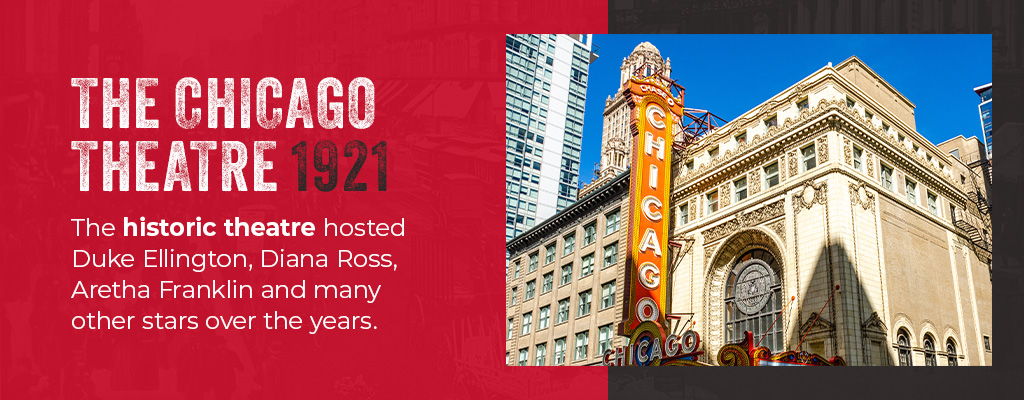
Chicago may be known for its iconic deep-dish pizza, with layers of saucy and cheesy goodness on a thick, golden-brown crust, but that’s not all there is to the Windy City. Chicago is a testament to architectural innovation and cultural richness, and its history draws tourists from all over the world. From towering skyscrapers to stunning parks, Chicago landmarks showcase the city’s vibrant culture.
This article shares a timeline of Chicago’s most notable attractions and the history behind them. So, grab your forks and get ready to dig in — this history is even deeper than the pizza.
History of Major Chicago Landmarks
Chicago’s story is written in its legendary landmarks, from the soaring skyscrapers downtown to the vibrant neighborhoods that showcase the unique cultures in the city. Each historic site, monument and attraction make up Chicago’s identity. Whether you’re looking for a specific Chicago landmark district or want to explore Chi-town’s rich history, here’s the ultimate Chicago landmarks list:
Grant Park – 1835
Referred to as “Chicago’s Front Yard,” Grant Park is nearly 313 acres of lakefront beauty filled with notable landmarks such as Millennium Park, Buckingham Fountain, the Art Institute of Chicago and the Museum Campus. It is also home to famous festivals, including Lollapalooza, Blues Fest and the Taste of Chicago. Originally known as Lake Park, Grant Park was renamed to honor the 18th United States President and Civil War General Ulysses S. Grant in 1901.
The Green Mill – 1907
America’s version of the Moulin Rouge in Paris (“Moulin Rouge” translates to “Red Mill”) had dancing girls, Champagne fountains, ballrooms and other luxuries. During prohibition, it downsized to the current lounge and became a speakeasy. The Green Mill was also significant in the development of Chicago-style jazz. In the 1920s, the club hosted pioneering performers like Tommy Dorsey. Al Capone and other gangsters also frequented the establishment. It was once owned by Jack McGurn, one of Al Capone’s notorious enforcers.
Wrigley Field – 1914
Home to the Chicago Cubs since 1914, Wrigley Field is one of Chicago’s most iconic landmarks. The field is used for more than just baseball and can host other events like ice hockey games, college football and charity events. The densely packed buildings surrounding the outfield offer fans a unique viewing experience. This view, combined with the park’s intimate design and strategic location in the heart of a residential neighborhood, has earned it the nickname “The Friendly Confines.”
Navy Pier – 1916
The Navy Pier attracts almost 9 million visitors each year and cost $4.5 million to construct. During World War II, the pier served as a training center for the U.S. Navy, giving it the name we know today. After the war, the pier fell into disuse until the city undertook significant redevelopment efforts in the 1990s, transforming it into a top entertainment and tourism destination. The 200-foot Centennial Wheel offers stunning views of the Chicago skyline and Lake Michigan.
The Chicago Theatre – 1921

Ellington, Diana Ross, Aretha Franklin and many other stars over the years. Visitors can take an hour-long guided tour, including a walk through the stage and dressing rooms, where many — including Frank Sinatra and Dolly Parton — have signed their names on the wall. The theater’s grand lobby, modeled after the Royal Chapel at Versailles, features a series of gallery promenades with French baroque art. Above the stage is the grand Wurlitzer theatre pipe organ, one of the oldest in operation today.
Buckingham Fountain – 1927
One of Chi-town’s most popular attractions and one of the largest fountains in the world, the Buckingham Fountain contains 1.5 million gallons of water, 134 jets and 820 lights. Located in the heart of Grant Park, it is constructed of Georgia pink marble and was designed to resemble the Latona Basin at Versailles. During spring and fall, the fountain showcases a 20-minute water display every hour, with a stunning light and music show at dusk.
Adler Planetarium – 1930
The Adler Planetarium, the western hemisphere’s first planetarium, houses one of the world’s best collections of astronomical artifacts, including the oldest known sundial (dated 1529) and other artifacts dating back to 12th century Persia. The Adler Planetarium showcases the history of space exploration and offers immersive experiences, such as the Grainger Sky Theater, which features state-of-the-art technology to simulate space travel. The building itself is also an attraction, with a 12-sided design representing the 12 signs of the zodiac and intricate astronomical details throughout.
Museum of Science and Industry – 1933
The Museum of Science and Industry, located in the former Palace of Fine Arts, was founded in 1933 and is the largest science museum in the Western Hemisphere. It was the first in North America to feature interactive exhibits, allowing visitors to engage with science hands-on. The museum’s permanent exhibits include a German submarine, a full-size replica coal mine and a whispering gallery. The more than 400,000 square feet of exhibits have attracted more than 180 million guests.
360 Chicago – 1969
360 Chicago is located on the 94th floor of 875 N Michigan Avenue, formerly known as the John Hancock Center. 360 Chicago offers stunning panoramic views of the city from 1,030 feet above the Magnificent Mile. The observation deck features floor-to-ceiling windows that allow visitors to see up to 55 miles in each direction on a clear day. The building’s distinctive X-braced exterior has made it an architectural icon and a defining feature of Chicago’s skyline since its completion in 1969.
Giordano’s – 1974
The original Giordano’s restaurant, located in Chicago’s historic South Side, launched a Chicago dining institution. The Boglio brothers transformed their mother’s “Italian Easter Pie” recipe from Torino, Italy, into a beloved deep-dish stuffed pizza, establishing a renowned pizza destination. Today, Giordano’s numerous locations are gathering spots where visitors can taste an authentic piece of the Windy City’s culinary history.
Willis Tower Skydeck – 1974
The Willis Tower — still known as the Sears Tower by many Chicagoans — is 1,450 feet and 110 stories tall. The Skydeck attracts more than 1.7 million visitors annually. On a clear day, visitors can see up to 50 miles and four states. A highlight of the Skydeck is The Ledge, a series of glass boxes extending 4.3 feet from the building’s exterior that allows visitors to experience the exhilaration of standing 1,353 feet above the ground.
Experience Chicago’s Historic Landmarks and Flavors
From historic parks to towering skyscrapers, Chicago’s landmarks vividly depict the city’s rich history, vibrant culture and architectural brilliance. Whether you’re a longtime resident or a first-time visitor, exploring these sites offers a deeper appreciation for the people, events and innovations that have shaped the Windy City.
As you explore the Windy City, pop into Giordano’s to experience an authentic taste of Chicago’s history. Find the nearest location and make your Chicago landmarks tour memorable.
